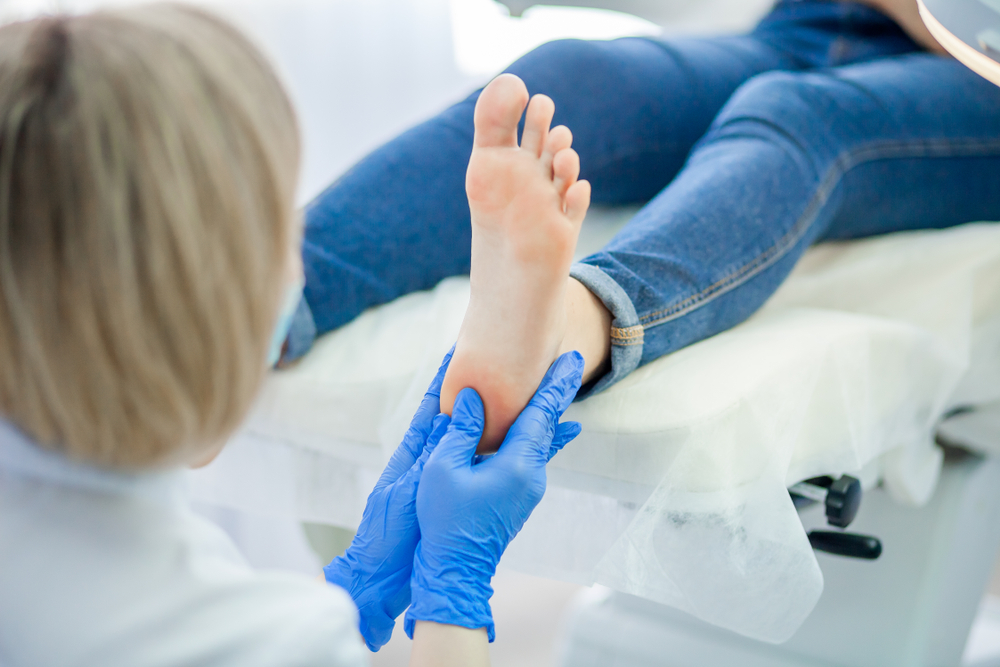
Can Heel Spurs Be Treated By A Podiatrist?
Heel spurs can significantly hinder daily activities and lower one’s quality of life. While many people may assume that surgery is the only option for treating heel spurs, podiatry offers a range of non-invasive treatments to help alleviate the symptoms. In this blog, we will explore what heel spurs are, their causes, and how podiatrists can effectively treat them, allowing you to get back to your daily routine without discomfort or pain.
Causes Of Heel Spurs
Heel spurs are a common foot condition that can cause pain and discomfort. They develop when calcium deposits accumulate on the heel bone’s underside, leading to a bony protrusion. Heel spurs are often associated with plantar fasciitis, a condition that causes inflammation and pain in the plantar fascia, a thick band of tissue that runs along the bottom of the foot from the heel to the toes. Heel spurs can form because the plantar fascia, which connects to the heel bone, becomes inflamed.
Other causes of heel spurs include repetitive stress on the feet, poorly fitting shoes, obesity, and other foot conditions such as flat feet or high arches. Understanding the underlying cause of heel spurs is important in determining the best course of treatment.
Symptoms Of Heel Spurs
Heel spurs, also referred to as calcaneal spurs, can be extremely painful and uncomfortable in the foot. Heel spurs can present with a number of symptoms, some of which are:
- Pain: The most common symptom of heel spurs is pain, which can be felt at the bottom of the foot or the back of the heel. The pain is usually worse in the morning when you first get out of bed or after long periods of sitting or standing.
- Inflammation: Heel spurs can cause inflammation in the affected area, leading to redness, swelling, and tenderness.
- Difficulty walking: Heel spurs can make it difficult to walk or stand for long periods of time. This is because the weight of the body puts pressure on the heel, causing pain and discomfort.
- Numbness or tingling: In some cases, heel spurs can cause numbness or tingling in the affected foot.
Diagnosing Heel Spurs
Diagnosing a heel spur usually involves a physical examination of the foot and an assessment of the individual’s medical history. A podiatrist will typically begin by asking the patient about their symptoms and the activities that may have contributed to the development of their condition. They may also perform a range of tests, such as checking for tenderness or swelling in the affected area, observing the patient’s gait or foot alignment, and conducting X-rays or other imaging tests to confirm the presence of a heel spur.
In some cases, other conditions such as plantar fasciitis or Achilles tendinitis may have similar symptoms to a heel spur, making an accurate diagnosis even more important. A podiatrist will use their expertise to identify the root cause of the pain and devise an appropriate treatment plan. Overall, early diagnosis is key to preventing the condition from becoming more severe and limiting the impact on an individual’s mobility and quality of life.

Treatment Options For Heel Spurs
Heel spurs are a common foot problem that can cause severe pain and discomfort. Fortunately, there are several treatment options available that can effectively manage the symptoms of heel spurs. Here are some of the most commonly used treatment options:
- Rest: Resting the foot is often the first step in treating heel spurs. Reducing the amount of time spent on the feet can help to alleviate the pain and allow the inflamed tissues to heal.
- Ice: Applying ice to the affected area can help to reduce inflammation and relieve pain. Wrap a towel around a bag of ice and apply it to the heel for 15-20 minutes at a time, several times a day.
- Medications: Over-the-counter pain relievers like ibuprofen and acetaminophen can help to reduce pain and inflammation associated with heel spurs.
- Physical therapy: Stretching and strengthening exercises prescribed by a podiatrist or physical therapist can help to alleviate pain and improve flexibility in the affected foot.
- Orthotics: Custom-made shoe inserts can help to redistribute weight and pressure on the foot, providing relief for the heel spur.
- Corticosteroid injections: If the pain is severe, corticosteroid injections may be administered by a podiatrist. These injections can provide temporary relief by reducing inflammation.
- Surgery: In rare cases, surgery may be recommended to remove the heel spur. This is usually only considered if other treatment options have been ineffective.
Preventing Heel Spurs
Heel spurs are a common foot problem that can cause severe pain and discomfort. They are often the result of repeated strain and stress on the foot, which leads to the development of bony growths on the heel bone. While treatment options are available for heel spurs, it is always better to prevent them from occurring in the first place. Here are some tips on how to prevent heel spurs:
- Wear proper shoes: The right shoes can go a long way in preventing heel spurs. Make sure you wear shoes that fit properly and provide good support to your feet. Avoid high heels, as they put excessive pressure on the heels.
- Stretching exercises: Stretching exercises can help prevent heel spurs by keeping the foot muscles and tendons flexible and strong. Regular stretching can also help reduce the risk of other foot problems.
- Maintaining a healthy weight: Excess weight puts added pressure on your feet, which can lead to the development of heel spurs. Maintaining a healthy weight can help reduce the risk of developing this foot problem.
- Avoid overuse: Overuse of the feet can lead to the development of heel spurs. Avoid activities that put excessive strain on your feet, such as running or jumping on hard surfaces.
- Treat foot problems promptly: Foot problems such as flat feet or high arches can lead to the development of heel spurs. Treating these problems promptly can help prevent the development of heel spurs.
When To Seek Help From A Podiatrist
If you are experiencing persistent heel pain, it is advisable to seek help from a podiatrist. They can perform a thorough evaluation to determine the cause of the pain and provide appropriate treatment options. Some signs that indicate you should see a podiatrist for your heel pain include:
- Pain that persists for more than a few days, even after rest and home remedies.
- Pain that is severe and limits your ability to walk or carry out daily activities.
- Swelling or redness in the affected area.
- Tingling or numbness in the foot.
- Pain that develops after a recent injury to the foot or ankle.
Ignoring heel pain can lead to the worsening of the condition and prolonged recovery time. Podiatrists can provide effective treatment options for heel pain, including custom orthotics, physical therapy, and shockwave therapy, among others. They can also offer advice on proper footwear, stretching exercises, and other preventive measures to reduce the risk of developing heel spurs in the future.
If you’re experiencing heel pain or suspect you may have heel spurs, don’t hesitate to schedule an appointment with a podiatrist. They can help you get back on your feet and enjoy an active, pain-free lifestyle.
Final Thoughts
Heel spurs can be a painful and debilitating condition, but with the right treatment and prevention measures, it is possible to manage and even eliminate the symptoms. It’s important to seek professional help if you experience persistent heel pain or suspect that you may have a heel spur.
At Upwell Health Collective, our team of experienced podiatrists can provide a comprehensive assessment, diagnosis, and treatment plan tailored to your specific needs. Contact us today to book an appointment and take the first step towards healthier, pain-free feet.
Please get in touch with us at Upwell Health at (03) 8849 9096 or book an appointment today.
